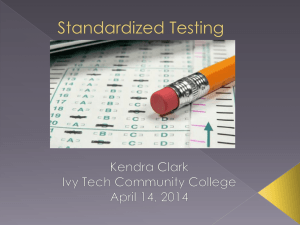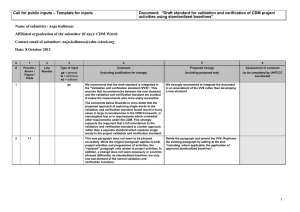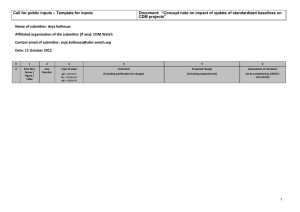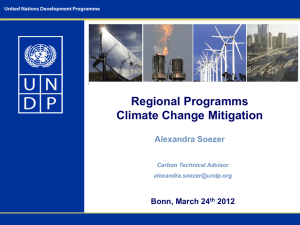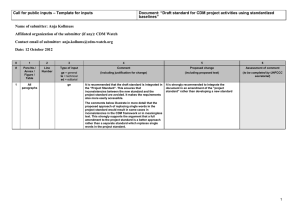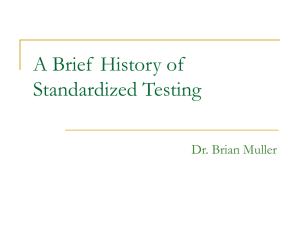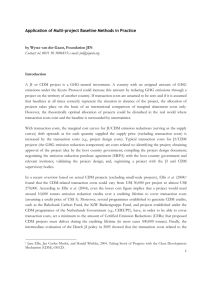STANDARDIZED BASELINES - CDM
advertisement
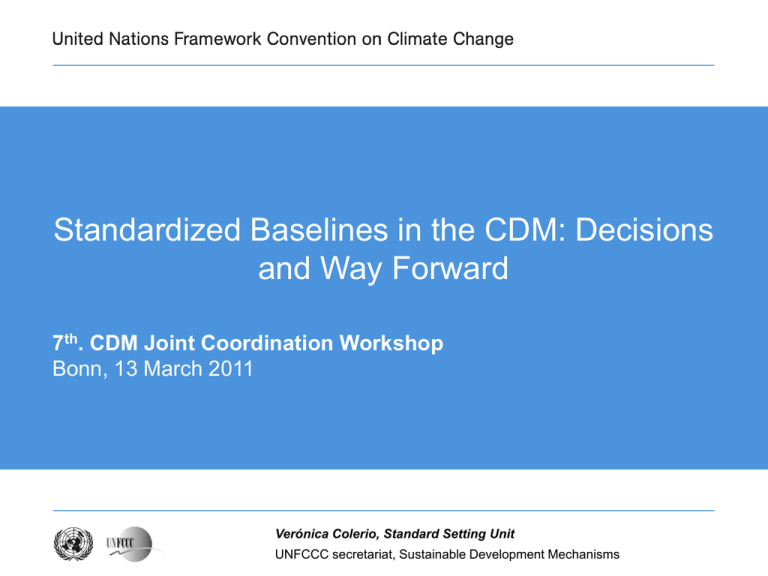
Standardized Baselines in the CDM: Decisions and Way Forward 7th. CDM Joint Coordination Workshop Bonn, 13 March 2011 Verónica Colerio, Standard Setting Unit UNFCCC secretariat, Sustainable Development Mechanisms BACKGROUND I CMP5 requested SBSTA to recommend modalities and procedures for the development of standardized baselines under the CDM that are broadly applicable, that provide a high level of environmental integrity and that take into account specific national circumstances. BACKGROUND II After two calls for submissions, a technical paper that took into account all submissions was prepared for CMP6 including the discussion on the following issues: Scope; Mandatory vs. optional; Procedures; Priorities; Access to CDM; The level of aggregation and the boundaries; Data quality, availability, collection and confidentiality; Financing; Accounting for developments over time, including past efforts. WHY STANDARDIZED BASELINES? Standardized baselines may: Improve efficiency by reducing transaction costs, complexity and uncertainty for project participants; Enhance transparency and objectivity; Facilitate access to the CDM; Contribute to the streamlining of CDM procedures; Promote the scaling-up of mitigation actions while ensuring environmental integrity. DECISION CMP6 Decided that Parties, PPs, as well as international industry organizations or admitted observer organizations through the host country’s DNA, may submit proposals for standardized baselines to the EB. Requested the EB to develop standardized baselines, in consultation with relevant DNAs, prioritizing methodologies that are applicable to underrepresented regions and project activity types. WHAT IS A STANDARDIZED BASELINE? CMP6 definition: baseline established for a Party or a group of Parties to facilitate the calculation of emission reduction and removals and/or the determination of additionality for clean development mechanism project activities, while providing assistance for assuring environmental integrity. SCOPE “… baseline established for a Party or a group of Parties to facilitate the calculation of emission reduction and removals and/or the determination of additionality…” Establishment of the Baseline Scenario; Determination of Baseline Emissions; Demonstration of Additionality. GEOGRAPHICAL AGGREGATION LEVEL “… baseline established for a Party or a group of Parties to facilitate the calculation of emission reduction and removals and/or the determination of additionality…” “… standardized baselines under the CDM should be broadly applicable, provide a high level of environmental integrity and take into account specific national, subnational or international circumstances, as appropriate, “ Subnational (e.g. several grids in a country) Party Group of Parties International: NAI Parties, all Parties, etc. Example: – Benchmark for PFC emissions from aluminium METHODOLOGIES AND SBs Recognizing that baseline and monitoring methodologies using standardized baselines can be developed, proposed by project participants and approved by the Board ... Baseline and monitoring methodologies are required; Framework - Principles Qualitative Algorithm Quantitative - Value SUBMISSION OF SBs Decided that Parties, PPs, as well as international industry organizations or admitted observer organizations through the host country’s DNA, may submit proposals for standardized baselines to the EB Existing procedures for PPs; Procedures needed for DNAs to sumit proposal for standardized baselines. TOP DOWN DEVELOPMENT OF SBs Requested the EB to develop standardized baselines, in consultation with relevant DNAs, prioritizing methodologies that are applicable to underrepresented regions and project activity types (energy generation in isolate systems, transport and agriculture). DNA consultation; LDCs, SIDS, underrepresented project types / countries; Specific sector requests. ROLE OF THE DNAs Standardized baselines provide an excellent opportunity to enhance the role of DNA’s in the wider CDM process: Proposals for standardized baselines can allow DNAs to better align the use of carbon financing with wider public policy goals (e.g. energy policies, sustainable agriculture policies); The data gathering process can be facilitated by DNAs; The baseline requirements can be better tailored to address the data availability issues of the Host Party, while maintaining environmental integrity; The enhanced capacity developed during this process can also contribute to enhanced use of carbon financing in underrepresented regions. WEB PAGE http://cdm.unfccc.int/about/standardized_baseline s/index.html
